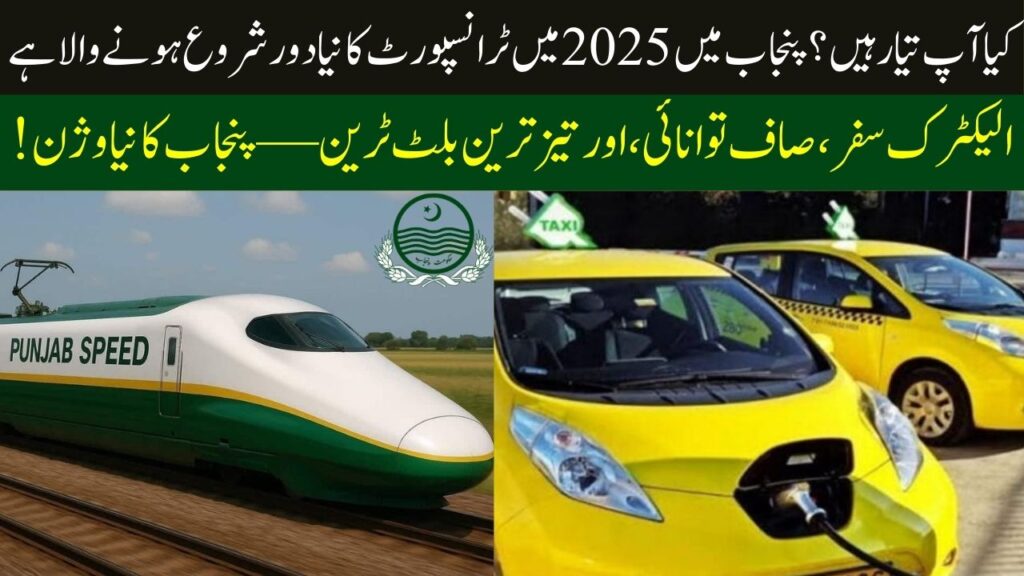Under Chief Minister Maryam Nawaz, the Punjab Green Revolution is embracing a future of sustainable transport and clean energy. From solar-powered e-charging stations to eco-friendly e-taxis and Pakistan’s first high-speed bullet train, the province is rolling out ambitious projects to transform public mobility and reduce environmental impact. These initiatives promise faster, greener, and more efficient services for residents while boosting economic growth. Here’s a deep dive into these game-changing developments.
Also Read: BISP Launches Bank Accounts for 9 Million Women: A Financial Empowerment Initiative
Punjab Green Revolution Key Transport and Energy Initiatives
In a recent high-level meeting, Maryam Nawaz unveiled a series of forward-thinking projects aimed at revolutionizing Punjab’s infrastructure. These decisions focus on sustainability, accessibility, and modern technology to meet the needs of a growing population.
Solar-Powered E-Charging Stations
To promote clean energy, Punjab is installing solar systems at e-charging stations across the province. This move reduces reliance on fossil fuels and supports the shift toward electric vehicles (EVs). Additionally, the government is exploring the integration of e-charging facilities at existing petrol pumps, making EV infrastructure more accessible.
Eco-Friendly E-Taxi Pilot
Punjab’s e-taxi project is a cornerstone of its green transport vision. The government has approved a financial model for a pilot phase launching 1,100 electric taxis. These e-taxis aim to cut pollution, lower fuel costs for operators, and provide affordable, eco-conscious transport for commuters.
Yellow Line Mass Transit System
The Yellow Line, a new mass transit project, is set to enhance Lahore’s public transport network. Connecting Jinnah Terminal to Harbanspura, the project’s feasibility study has been reviewed, and Chief Minister Maryam Nawaz has directed authorities to begin work promptly. This initiative will ease traffic congestion and offer reliable commuting options.
Gujranwala Mass Transit Expansion
To improve connectivity in Gujranwala, the government is studying additional routes for the city’s mass transit system. The focus is on designing routes that prioritize public convenience and accessibility, ensuring more residents benefit from modern transport solutions.
Pakistan’s First Bullet Train: Lahore to Rawalpindi
A landmark project, Pakistan’s first high-speed bullet train will connect Lahore and Rawalpindi, slashing travel times and boosting regional connectivity. A working group, led by Punjab Senior Minister Maryam Aurangzeb and Federal Railways Minister Hanif Abbasi, is finalizing the feasibility study and timeline. The group, which includes Punjab Transport Minister Bilal Akbar and the Chairman of Pakistan Railways, will present its recommendations soon.
| Project | Key Details | Impact |
|---|---|---|
| Solar E-Charging Stations | Solar-powered stations at key locations and possibly petrol pumps | Reduces fossil fuel use, supports EVs, lowers charging costs |
| E-Taxi Pilot | 1,100 electric taxis in pilot phase | Cuts pollution, reduces fuel costs, offers affordable transport |
| Yellow Line Transit | Mass transit from Jinnah Terminal to Harbanspura | Eases traffic, improves public transport in Lahore |
| Gujranwala Transit | Additional routes under study for public convenience | Enhances connectivity, supports urban mobility |
| Lahore-Rawalpindi Bullet Train | High-speed rail with feasibility study in progress | Faster travel, boosts economy, strengthens regional links |
Why These Projects Matter
These initiatives are more than just infrastructure upgrades—they’re a blueprint for a sustainable, connected Punjab. Here’s why they’re significant:
- Environmental Benefits: Solar-powered charging and e-taxis reduce carbon emissions, helping combat air pollution in urban centers.
- Economic Growth: Modern transport infrastructure attracts investment, creates jobs, and supports local businesses.
- Public Convenience: Faster, reliable transit options like the Yellow Line and bullet train improve daily commutes and regional travel.
- Cost Savings: Solar energy and electric vehicles lower operational costs for transport providers, potentially reducing fares for users.
What’s Next for Punjab?
The Punjab government is moving swiftly to turn these plans into reality. The bullet train’s feasibility study is nearing completion, with proposals expected within weeks. The e-taxi pilot and Yellow Line projects are also on fast tracks, with timelines for implementation being finalized. Meanwhile, solar e-charging stations are set to expand, paving the way for broader EV adoption.
Frequently Asked Questions
What is the purpose of the e-taxi project?
The e-taxi initiative introduces 1,100 electric taxis to reduce pollution and fuel costs while offering affordable, eco-friendly transport.
Where will solar-powered e-charging stations be located?
They will be set up at strategic charging points across Punjab, with potential expansion to petrol pumps for greater accessibility.
What is the Yellow Line mass transit system?
It’s a public transport line connecting Jinnah Terminal to Harbanspura in Lahore, designed to reduce traffic and improve commuting.
When will the Lahore-Rawalpindi bullet train be operational?
The timeline is still under development, but the feasibility study and planning are actively progressing.
Who is overseeing the bullet train project?
A working group including Punjab Transport Minister Bilal Akbar, the Chairman of Pakistan Railways, and other officials, reporting to Maryam Nawaz.
Conclusion
Punjab is on the cusp of a transport and energy revolution, driven by Chief Minister Maryam Nawaz’s vision for sustainability and innovation. Solar-powered e-charging stations, a fleet of 1,100 e-taxis, the Yellow Line transit system, and Pakistan’s first bullet train signal a commitment to greener, faster, and more efficient public services. These projects promise to reduce pollution, lower costs, and enhance connectivity, transforming how Punjab moves and grows. As these initiatives take shape, residents can look forward to a cleaner, more connected future. Stay tuned for updates on this exciting journey.
